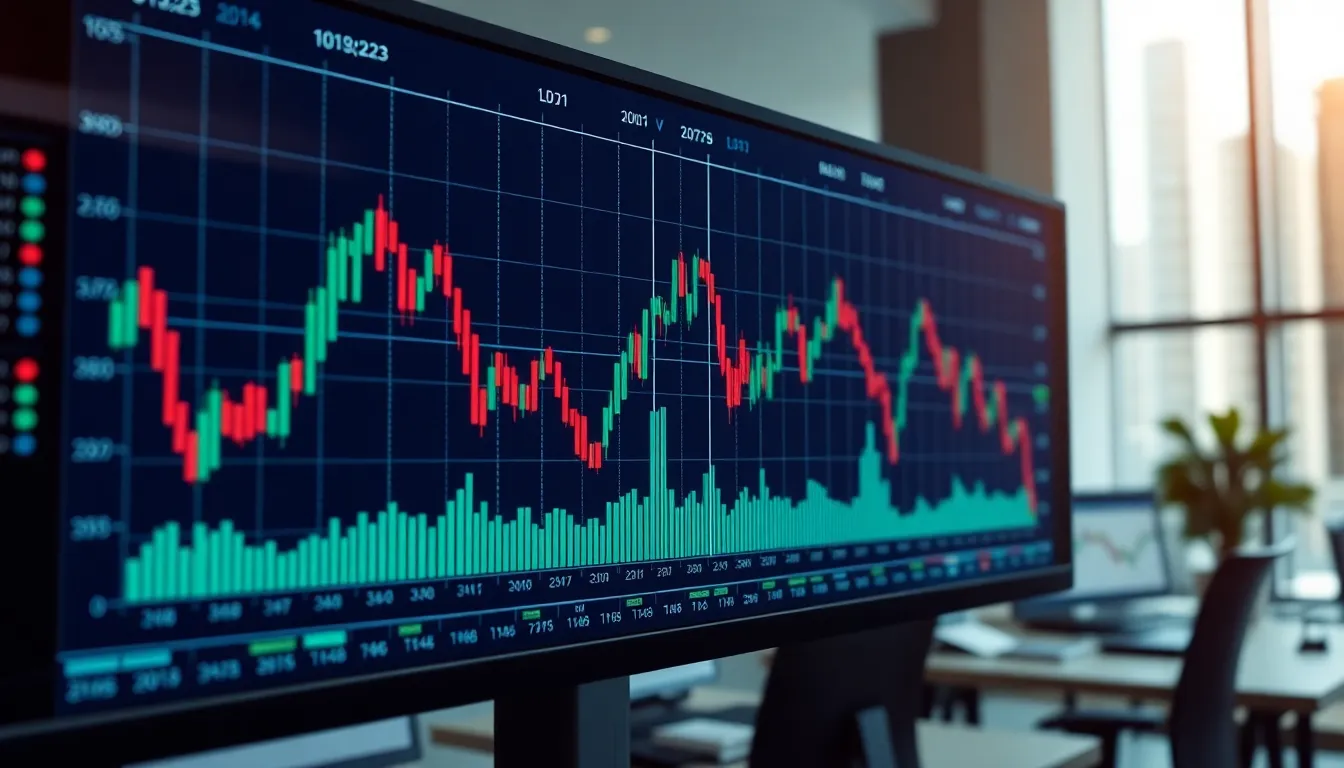Table of Contents
ToggleWhen it comes to the stock market, the NYSE graph is like a roller coaster ride—thrilling, unpredictable, and not for the faint of heart. Investors and analysts alike keep a close eye on these graphs, hoping to spot trends that could lead to big wins or, at the very least, avoid a financial nosedive. It’s a visual representation of the highs and lows of the market, and understanding it can make all the difference in turning a profit.
Overview of NYSE Graph
NYSE graphs provide critical insights into market behaviors, demonstrating price movements and trading volumes over time. Investors and analysts rely on these visuals to navigate the complex landscape of the stock market.
Understanding Stock Market Graphs
Stock market graphs represent price changes and trends of individual stocks or indices. Each graph typically displays time on the horizontal axis and price on the vertical axis. Candlestick charts and line graphs are common types. Patterns within these graphs can signal buy or sell opportunities, guiding investment strategies. Real-time tracking allows traders to react promptly to market conditions. By interpreting these visual data points, investors gain a clearer understanding of market dynamics.
Importance of Data Visualization in Trading
Data visualization plays a key role in trading decisions. Effective visualization simplifies complex data, enabling quicker analysis and informed choices. Charts highlight trends, fluctuations, and trading patterns that might be missed in raw data. Immediate recognition of market changes enhances decision-making processes. Visual tools also help minimize cognitive overload, allowing traders to focus on critical information. Overall, powerful data visuals foster strategic trading advantages.
Key Components of NYSE Graph

Understanding key components of the NYSE graph enhances market analysis and trading strategies. Investors use these components to make informed decisions.
Price Movement
Price movement represents the changes in stock prices over time, illustrating the market’s behavior. Charts display historical prices and fluctuations that help identify trends and patterns. Observing these movements can signal potential buy or sell opportunities. Analysts often focus on recent price shifts to gauge market sentiment. A sudden spike in price might indicate increased interest or speculation. Conversely, sharp declines can prompt caution among traders. Using this data effectively contributes to successful investment management.
Volume Analysis
Volume analysis examines the number of shares traded during a specific period. High trading volume often correlates with significant price changes, indicating strong market interest. Observers pay close attention to volume spikes as they can highlight potential reversals or continuations in trends. An increase in volume alongside a price increase suggests robust confidence among buyers. Low volume, on the other hand, may indicate weaker support for price movements. Analyzing volume helps traders identify genuine trends versus misleading price changes.
Moving Averages
Moving averages smooth out price data over a specific timeframe, providing clearer trend visualizations. Investors commonly use both simple and exponential moving averages to assess market conditions. A simple moving average calculates the average price over a set period, while the exponential version gives more weight to recent prices. Crossings of moving averages can signal potential buy or sell points. For instance, a short-term average crossing above a long-term average often signals bullish momentum. Recognizing these patterns enhances strategic decision-making in trading.
Types of NYSE Graphs
Understanding the types of graphs used on the NYSE aids in analyzing market trends and making informed decisions.
Line Charts
Line charts illustrate price movements over time by connecting data points with a continuous line. They allow traders to visualize trends clearly, as each point represents the stock price at a specific time interval. Investors often use line charts to identify long-term trends, as they highlight overall movement without the distractions of daily price fluctuations. Since line charts only display closing prices, they simplify the analysis, making them a popular choice for assessing historical performance.
Bar Charts
Bar charts represent price movements using vertical bars, which indicate the open, high, low, and close prices for a specific period. Each bar provides a comprehensive view of price activity, giving insight into market volatility and trading ranges. Traders rely on bar charts to assess potential entry and exit points, as they visually depict where the stock opened and closed within a given timeframe. The ability to see multiple periods at once allows investors to spot patterns and trends effectively.
Candlestick Charts
Candlestick charts combine elements of line and bar charts, displaying price data in a format that highlights market sentiment. Each candlestick consists of a body, which shows the opening and closing prices, and wicks that indicate the high and low prices during a trading period. Traders use candlestick patterns to gauge market momentum, as certain formations can signal potential reversals or continuation of trends. The detailed visualization aids analysts in making timely decisions, enhancing their trading strategies.
Tools for Analyzing NYSE Graph
Analyzing NYSE graphs requires effective tools that enhance understanding of market movements.
Charting Software
Charting software offers powerful capabilities to visualize stock price movements. Popular tools such as TradingView and MetaTrader provide various customizable chart types. Users can track individual stock or index performance using multiple graphical styles. Features include indicators, drawing tools, and the ability to overlay trends. Many investors utilize these features to refine trading strategies and identify buy or sell signals.
Technical Indicators
Technical indicators assist traders in making informed decisions based on market data. Common indicators include moving averages, Relative Strength Index (RSI), and Bollinger Bands. Each indicator provides unique insights into price trends and market sentiment. For instance, moving averages smooth out price fluctuations, enabling clearer trend identification. Understanding these tools empowers traders to capitalize on potential market opportunities and mitigate risks.
Online Platforms
Online platforms serve as essential resources for accessing and analyzing NYSE graphs. Sites like Yahoo Finance and Bloomberg provide users with real-time data and comprehensive analytical tools. Investors access extensive information, including historical data, financial news, and market trends. Many platforms also feature user-friendly interfaces for quicker navigation. Leveraging these resources accelerates decision-making and supports strategic financial planning.
Mastering the NYSE graph is vital for anyone looking to navigate the stock market effectively. These visual tools not only reveal price movements and trading volumes but also highlight trends that can lead to profitable investments. By utilizing various graph types and analytical tools traders can enhance their decision-making processes and respond swiftly to market changes.
Investors who leverage data visualization gain a competitive edge. Recognizing patterns and understanding market dynamics fosters strategic trading advantages. As the market continues to evolve staying informed and adaptable is key to successful investing. Embracing the insights offered by NYSE graphs will empower traders to make informed choices and optimize their financial outcomes.







